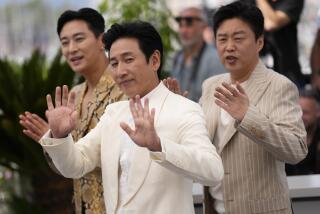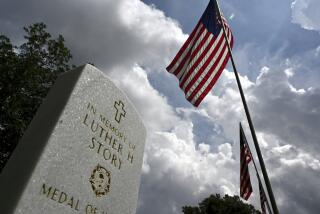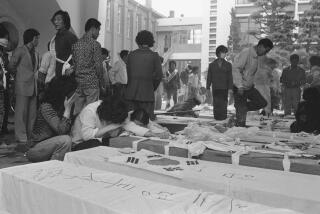South Korean agent haunted by a voice from beyond
- Share via
Reporting from Tokyo and Seoul — As a former South Korean intelligence agent, Kim Young-kwang knows all about subterfuge, secret documents and international intrigue.
But that’s just soulless spy craft compared with what he considers the most engaging case of his life. It’s a 100-year-old riddle that involves heroes from two nations, a Chinese prison, a Buddhist monk, a dose of Seoul politics -- and a voice from the grave.
For more than two decades, Kim has traveled across the region to sift through yellowing archives, interview witnesses and amass a vault of evidence, all in hopes of answering a nagging question:
Where are the remains of Ahn Jung-geun?
On Oct. 26, 1909, the 30-year-old Korean nationalist walked into a crowded train depot in Harbin, China, and fired six shots at Japanese statesman Ito Hirobumi. Three of the bullets hit their mark; Ahn had killed the man he blamed for Imperial Japan’s move to annex his homeland. Five months later, an unrepentant Ahn was hanged in a prison in Japanese-occupied northeastern China.
Before going to the gallows, Ahn asked that his body be returned to his native Korea, a request denied by his captors, according to Japanese diplomatic documents.
From there, the record fades. Papers kept by Ahn’s captors are unclear about where his body was buried.
The uncertainty has kept alive visceral feelings among both Japanese and Koreans -- about the assassination and Japan’s 20th century record of imperialism. The emotions can’t be put to rest, many feel, until Ahn receives a proper burial.
“This mystery is complicated because Ahn is such a polarizing historical figure,” said Kim, now 79. “He is revered in Korea, but demonized in Japan.”
As an agent in South Korea’s Central Intelligence Agency, Kim never lost his appetite to solve his nation’s biggest cold case, spending hours in libraries researching Ahn’s troubled life.
Then, in 1987, as he began the last of three terms as a national lawmaker, Kim decided he wanted to see the prison where Ahn died. There was one problem: South Korea didn’t have diplomatic relations with China at the time, so he couldn’t get a visa.
But there was no stopping this old spy.
The man Ahn killed is considered the father of modern-day Japan. Ito established Japan’s Cabinet system in 1885 and became the country’s first prime minister, a post he held four times. In the early years of the 20th century, he served as his country’s first resident-general in Korea, which was then a Japanese protectorate. For years, Ito’s image graced the nation’s 1,000-yen note.
Ahn, who was born in what is now North Korea, has mythic status of his own. Viewed as a martyr for Korean independence, he has been the subject of a film, play, musical and opera. He once cut off part of a finger in a pledge to avenge Japanese atrocities in Korea.
Kim’s interest in Ahn dates to his youth. As a teenager, he played the lead role in a high school play about Ahn. Later, Kim began reading widely on the man he considers a political visionary. He became intrigued by the mystery surrounding Ahn’s remains.
In 1987, tired of speculation, Kim decided to see whether he could find the grave himself.
Bribing a Chinese Foreign Ministry official in Hong Kong, he sneaked into China and managed to reach Lushun prison, near the northeastern city of Dalian, before being arrested and deported. “The only thing I accomplished was getting reprimanded by the Chinese,” he said.
He would make nearly a dozen other forays across the border, visiting the prison and archives in nearby cities.
In 1989, he tried a different tack. He visited Ito’s great-grandson in Japan and proposed that he meet and shake hands with Ahn’s grandson. Kim hoped the publicity would draw attention to his cause and shake loose information about the location of Ahn’s remains.
Ito agreed to the meeting, but Ahn’s grandson, who lives in the San Francisco Bay Area, refused, Kim said. The grandson did not respond to requests for an interview.
Today, Kim is back in Seoul and still engrossed in the case. At a social club, he spreads his research across a table -- thick, dog-eared folders with detailed notes from interviews, annotated maps and hand-drawn diagrams of the prison.
He flips through his papers slowly, lovingly, like an old professor still impassioned by the questions he asked as a young man.
This much he knows: About 1 p.m. on March 26, 1910, Ahn’s body was placed in a coffin by workers at Lushun prison, according to prison records.
Ahn’s two brothers, who showed up to collect the body, were rebuffed. A 1910 letter from a Japanese consul in Harbin to the Japanese foreign minister hints at one reason for the secrecy surrounding Ahn’s remains: concern over their political symbolism.
“If Ahn Jung-geun’s body is handed over to the surviving family or impudent Koreans . . . I think it will not be good in the future,” the consul wrote. “Please take great caution on this matter.”
In the course of his quest, Kim sought out Taiken Saito, a monk at the Dairinji temple in northern Japan. Buried at the temple is Toshichi Chiba, a former Japanese prison guard who had befriended Ahn and was with the condemned man until his death.
Ahn left his last writing with Chiba: a scroll in Chinese calligraphy that reads, “A soldier’s duty is dedication to the country.”
Caring for Chiba’s grave, Saito researched Ahn and worked with the Chiba family to return the scroll to South Korea in 1979.
For 30 years, Saito has hosted annual memorial services for Ahn -- both to carry out Chiba’s intent and show regret for his country’s actions in Korea. The services have prompted death threats against Saito. Japanese researchers looking into Ahn’s life also have been threatened.
Saito, 74, said he thinks the body will never be found.
“China may have it,” he said. “But because Ahn is from [the North], they can’t hand over something like that to North Korea and it wouldn’t be right to give it to South Korea either. So if they have it, they may not know what to do.”
In recent years, Kim located a Korean who grew up in China and who said he had often visited Ahn’s grave at a cemetery about 1,250 feet east of the prison, an area that has long since reverted to woodland.
Kim believes the man’s story is solid evidence contradicting the view of many South Korean scholars that Ahn’s body was buried in a field north of the prison.
In 2005, China, South Korea and North Korea agreed to conduct an excavation at the prison in hopes of finding the grave.
Three years later, as a team of South Korean experts prepared to go to Lushun, Kim approached the Ministry of Patriots and Veterans Affairs with his information.
But officials wouldn’t listen, he said. Instead, they dug at the northern site, an effort that yielded only an old garbage dump.
“It came down to politics,” Kim said. “I was a member of the minority party, so they wouldn’t listen to reason.”
South Korean officials say that isn’t so. “We thank Mr. Kim for his work,” said Hwang Yong-hae, an official at the Ministry of Patriots and Veterans Affairs. “We just don’t agree with him.”
Now Kim has proposed using advanced radar -- even a mystic -- if that’s what it takes.
He plans to meet with officials in Hwang’s agency as South Korea marks the 100th anniversary of Ahn’s death later this month.
“It’s going to be a showdown,” he said. “I want to see the end of this.”
Recalling one of his trips to the Lushun prison, Kim said he wept inside the room where Ahn was hanged as he examined the instruments that Japanese guards used to torture him and other prisoners.
As he wandered the grounds, he said, he heard a man’s voice, one that has since visited him in his dreams. “It said: ‘Why are you here 100 years later? Can’t you see I’m cold here?’ ” Kim recalled.
“I know it’s him. And he is not happy. It is a scolding voice. He is reprimanding me.”
Nagano is a special correspondent. Ju-min Park in The Times’ Seoul Bureau contributed to this report.
More to Read
Sign up for Essential California
The most important California stories and recommendations in your inbox every morning.
You may occasionally receive promotional content from the Los Angeles Times.














